Our Superconducing Consciousness
A synthesis of neurophysiology, alchemy, and yoga into a theory of transcendental experience
A synthesis of neurophysiology, alchemy, and yoga into a theory of transcendental experience
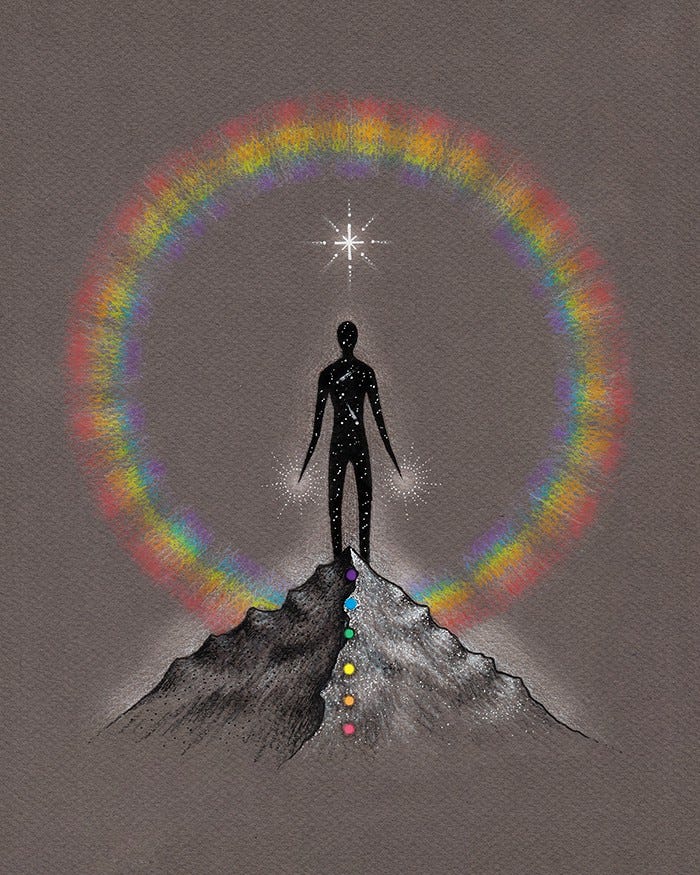
“Behind it all is surely an idea so simple, so beautiful, that when we grasp it — in a decade, a century, or a millennium — we will all say to each other, how could it have been otherwise?”
— John Archibald Wheeler, 1986
Note: If you would prefer to read this as a pdf manuscript, it is available here.
1. Introduction
2. The Electric Body
∘ 2.1 Semiconducting Neurophysiology
∘ 2.2 Biomagnetism
∘ 2.3 Rivers of Light
3. Spooky Engineering
∘ 3.1 Super-Conduction
∘ 3.2 Quantum Mechanical Crash Course
4. Modern Alchemy
∘ 4.1 Material Transmutation
∘ 4.2 Psychological Transmutation
5. Waves of Cerebrospinal Fluid
∘ 5.1 Soaring Up
∘ 5.2 A Magnetic Axis
6. Transcendental Experience
∘ 6.1 Kundalini and Quantum Tunneling
∘ 6.2 Your Ajna Chakra
∘ 6.3 The Psychonaut’s Journey
7. All in All
8. ReferencesSpecial thanks to Pasquale Caccavella for his inspiration and for his contributions to these thoughts.
1. Introduction
There is a rich history of religious experience in our world, yet our current western society has no acceptable framework through which to make sense of it. We accept the conclusion that mystical perceptions are unscientific, or simply not worth our time.
Ever since Copernicus’ proposition that the Earth was not the center of our universe, science has steadily been eroding the authority of mystical teachings about our cosmos. We have become stuck in a worldview that is entirely Newtonian, believing every observation to be explained by the physical laws of nature. Slowly but surely, we have chipped away at the idea of spirit.
“We still believe in a material world built of matter and psychical forces. And we cannot connect the psychical existence or substance with the idea of anything cosmic or physical. We have not yet found the bridge between the ideas of physics and psychology.”
— Carl Jung, Lecture 3, The Psychology of Kundalini Yoga (1932)
I believe that 90 years of research into the quantum implications of super-conduction, coupled with the exploration of our electrical neurophysiology, have provided the bridge which Jung had hoped to see. Modern scientific research and misunderstood esoteric traditions seem to be pointing us towards a radical conclusion: our bodies are superconductors. In this essay, I hope to provide a theory as to how this could possibly lead to transcendental experience.
Science and religion are both an aperture through which to consider these ideas. No matter which direction you look from, it is a truth that you must find for yourself. I hope that we can all consider these musings genuinely, and then judge for ourselves what resonates within the realm of possibility.
“The day science begins to study non-physical phenomena, it will make more progress in one decade than in all the previous centuries of its existence.”
— Nikola Tesla
2. The Electric Body
2.1 Semiconducting Neurophysiology
Eastern medicine is based around the idea of a universal life-force energy that flows through all things. Acupuncture, yoga, Tai Chi, Chi Gong, Healing Tao, Reiki, and a wealth of other names have been given to practices that supposedly tap into this field of energy. It has been the inspiration for science fiction for decades, pervading popular culture in the guise of myth.
“The Force is what gives a Jedi his power. It’s an energy field created by all living things. It surrounds us and penetrates us. It binds the galaxy together.”
— Obi-Wan Kenobi, Star Wars: Episode IV — A New Hope
When the neurotransmitter acetylcholine was discovered by Henry Dale, the idea of bio-electricity, or this life-force energy, seemed debunked. We could see nerve cells communicating like a game of telephone, passing chemical messengers from cell to cell in a long chain. Instead of acting like electricity in a wire, we could see nerves behaving like chemistry. There was no longer anything mystical about our bodies’ energy lines.
Henry Dale’s discovery was just a step in the history of science debunking mystical ideas. We now live in an era of strict rationalism. Any notion of spirit or mystical experience is squashed under the heavy hand of science. We contend that the mystics and shamans of antiquity who claimed to cure disease with song and spirit were nothing more than charlatans.
There are still curious scientists, however, who have refused to abolish mystery. Dr. Szent-Gyorgyi, a Nobel Prize laureate in physiology, suggested that the mechanistic approach to biochemistry was insufficient. He saw that when we break living things down to pieces, somewhere along the line life slips through our fingers. At a certain point, we are left working with dead matter (Becker, 1995). As a pioneer in the field of bio-electricity, Dr. Szent-Gyorgyi believed that this universal energy still existed in all living things.
Our understanding of the human body took a U-turn in the early 1960s when Dr. Robert Becker provided evidence for a new kind of electrical system within the human neuroanatomy. Even though the nerves themselves didn’t conduct signals like an electrical wire, he postulated that something else still could.
Dr. Becker proved that the human body consists of an intricate web of direct current (DC) electrical circuits through the myelination of nerve cells (Becker, 1995). Schwann cells are the myelinated cells of the peripheral nervous system (Figure 1). They are like the rubber around a copper wire, yet these supposed insulators can circulate an unbroken electrical charge throughout the entire length of the body. Better yet, he proved that these myelinated cells were semi-conductors (Becker, 1995).
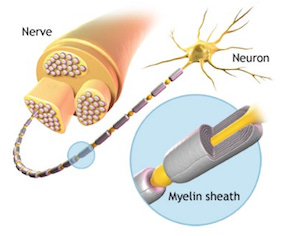
“The cells that biologists had considered merely insulation turned out to be the real wires.”
— Robert Becker, The Body Electric
Dr. Becker found that these semiconducting myelin sheaths were what caused salamanders’ limbs to regenerate. The DC current acts as an information network, allowing the fingers and toes of a recovering salamander to grow in the right place. Recent work has validated these findings, showing that DC electrical impulses can stimulate bone, cartilage, and blood vessel formation (Leppik, 2015).
2.2 Biomagnetism
One important fact about electromagnetism is that any electrical potential will produce a magnetic potential (Helmenstine, 2018). When electrons flow through a wire, a voltage difference is created which causes a magnetic field to surround the wire (Britannica, 2021). The stronger the current, the larger the field. This is known as the Hall effect.
Dr. Becker found an axial current running from the bottom of your body up towards your head (Figure 2a). He found that this field is characteristic of all living creatures.
In terms of basic electromagnetism, when a current is run through a coiled wire, or a solenoid, then the surrounding magnetic field will run up and through the coil (Figure 2b). This is strikingly similar to the energetic channels of yoga, through which the Kundalini rises. (Figure 2c).
‘The coiled-up energy of action is Kundalini, “the coiled up.”’
— Swami Vivekananda, Raja Yoga
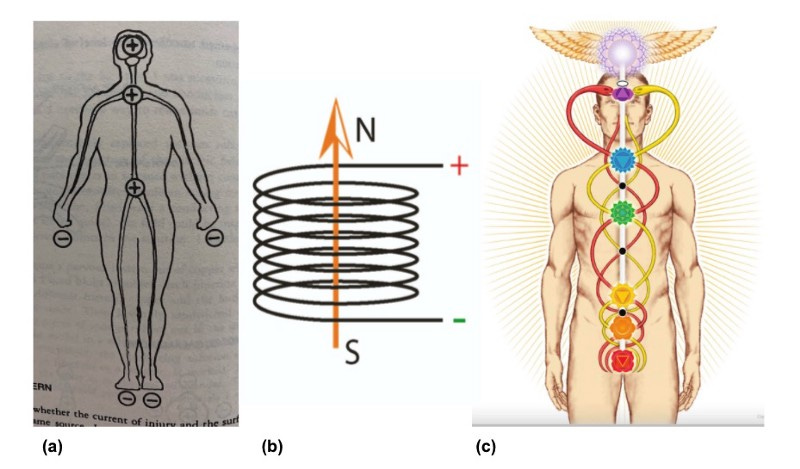
When current flows through a coiled channel, the magnetic field forms the shape of a toroid around the conductor. It runs up and through the coil, down and around the outside, and then up through the coil again to complete the loop.
The existence of a toroidal magnetic field surrounding the human body has been validated on numerous occasions. It fluctuates in magnitude, but its existence has been confirmed [(Kuman, (2018), (Becker, 1995), (Uchikawa, 1992), (Dispenza, 2017)]. This is precisely the behavior and shape of the Earth’s magnetic field, which is caused by the magnetic poles of the earth running through swirls of molten metal in the Earth’s core (Figure 3) (Buis, 2021).

These magnetic fields can influence other conductors if brought into close enough proximity. Magnetic fields will attract or repel one another, resulting in a measurable change in the current. Imagine holding a magnet in each hand, and now feel the force acting to pull your hands together or press them apart. That repulsion or attraction can be detected and measured in normal conduction and will influence a flowing current.
Dr. Becker tested this principle on living salamanders, attempting to interfere with the electrical conduction of their brains. He found that when he brought an interfering magnetic field near the brains of salamanders, they would fall unconscious. When he removed the interfering field, they would regain consciousness and begin moving around as if nothing had happened. This demonstrated a direct link between the strength of endogenous (within the body) electrical conduction and the quality of consciousness (Becker, 1995).
Finally, Dr. Becker showed that the peripheral nervous system, consisting of all the nerves which jettison out from the spine, is a network of closed DC circuits. He observed that motor neurons send negative charges out to the body, while sensory neurons reverse that polarity back to the spine.
He found that these reflex arcs correspond with the meridian lines of Eastern medicine [(Becker, 1995), (Pitkanen, 2013)]. Running custom-built electrodes along the large-intestine and pericardial meridian lines, he detected the same electrical characteristics of DC conduction in all of the people he observed (Becker, 1995). Other researchers have continued this work and reproduced his findings [(Chen, 2013), (Chang, 2019)].
Dr. Becker summarized his life’s work with the conclusion that living matter is an effective semiconductor. He showed that the human body consists of a collection of closed circuits, all conducting information along defined pathways.
This electrical network behaves like a symphony composer, organizing the cacophony of cells within our bodies and directing them to become healers, infection fighters, structural support, memory, muscle, or any other specialized cell of the body.
2.3 Rivers of Light
“The experiences encountered under the influence of mescaline or deep hypnosis are very strange; but they are strange with a certain regularity, strange according to a pattern… First and most important is the experience of light. Everything seen by those who visit the mind’s antipodes is brilliantly illuminated and seems to shine from within.”
— Aldous Huxley, The Doors of Perception
This semiconducting network discovered by Dr. Becker has been shown experimentally to correspond with the energy lines of Eastern philosophy. In acupuncture and Chinese philosophy, these pathways are known as meridians. In yoga and Indian philosophy, they are called nadis. These terms refer to the same network (Figure 4).
Likewise, the yogis of India gave the energy flowing through these channels the name of prana. The Chinese call it chi. Ralph Waldo Emerson called it “the transcendent simplicity and energy of the Highest Law” (Emerson, 1841). This is what Dr. Szent-Gyorgyi believed had been lost in reductionistic biochemistry.
“I envisioned hundreds of little DC generators like dark stars sending their electricity along the meridians, an interior galaxy that the Chinese had somehow found and explored by trial and error over two thousand years ago.”
— Dr. Robert Becker, The Body Electric
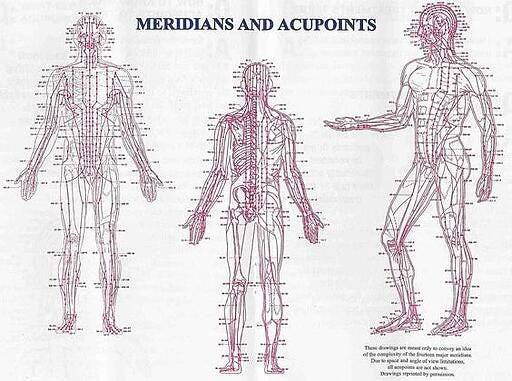
Professor Kaznachejew at the Institute for Clinical and Experimental Medicine in Novoskibirsk was curious what the skin’s reaction to light in the visible spectrum would be. He found that white light was able to spread under the skin, emanating from within the body at these known acupuncture points. Dr. Gregory Raiport was one of the researchers to reproduce this work, using lasers to send visible electromagnetic waves through the acupuncture-meridian system (Dale, 2008). They found Dr. Becker’s DC system operating like a network of fiber optic cables. Visible light was being transmitted throughout the body.
Notably, the Incan tradition contains its own energetic system for defining these meridians. The ancient Columbian Americans called these circuits rios de luz, or rivers of light.
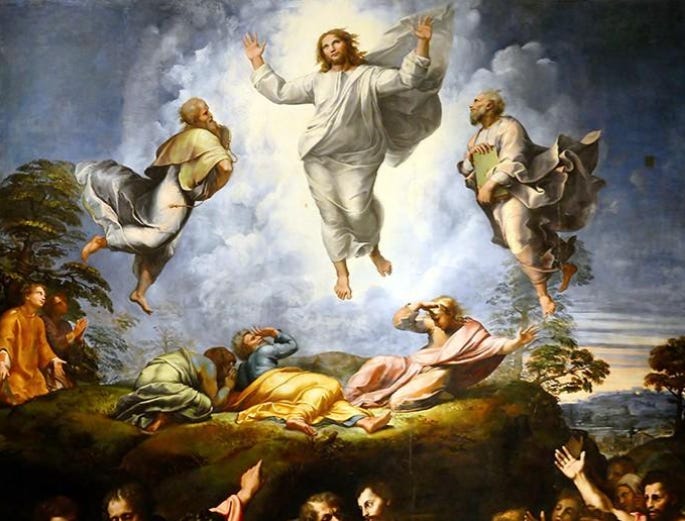
Spiritual experience, for all of time, has been closely linked with the depiction of blinding light. For us in the West, no image has been so ingrained in our psyches as the Transfiguration of Christ. Peter, James, and John beheld the terrifying mystery of their teacher’s Christ Consciousness (Figure 5). He is described to have been consumed in a blinding, all-encompassing light.
“There he was transfigured before them. His face shone like the sun, and his clothes became as white as the light.”
— Matthew 17:2–3
Similarly, Saul’s conversion into Paul on the road to Damascus was a result of a sudden realization of God. During his travels, “a bright light from heaven flashed around [him].”
‘“Get up,” the Lord said, “and go into Damascus. There you will be told all that you have been assigned to do.” My companions led me by the hand into Damascus, because the brilliance of the light had blinded me.’
— Acts 22:10–11
This same link between blinding light and spiritual experience is repeated in the dreams of Ezekiel (Ezekiel 1:4), the revelations of John (Revelation 1:12–16), the radiance of Moses (Exodus 35:29–35), the prophesies of Isaiah (Isaiah 9:2–3), the trials of Job (Job 37:21–38:2), the hymns of Psalms (Psalm 139:7–12), the visions of Daniel (Daniel 10: 5–6), and the Pentecost of the disciples (Acts 2:1–4).
“For this reason I say, if one is whole, one will be filled with light, but if one is divided, one will be filled with darkness.”
— The Gospel of Thomas (61), The Nag Hammadi Scriptures
3. Spooky Engineering
3.1 Super-Conduction
Semi-conducting perineurial (peri-neural, around the nerve) cells, which appear to transmit light like fiber optic cables, are a notable quirk of biology. Semiconductors outside of crystal lattice geometries are rare; the low resistance within a crystal lattice is necessary for such free movement of charge-carriers. It is this phenomenon we can thank for the silicon chips of our modern computational age. A charge can move very easily through a semiconductor, and as the temperature cools to zero the resistance in the wire also approaches zero. At this critical threshold of coolness, the semiconductor is then in a special state of super-conduction.
The greatest contribution to our knowledge of super-conduction came from physicist Dr. Brian Josephson. He mathematically showed that if two superconductors were placed close to one another, with an insulating layer in between, the charge would move through the insulator with zero resistance. This is like claiming water could flow with no turbulence through a brick wall, so long as there is a special kind of flow occurring on each side of that wall (Strogatz, 2003).
Dr. Josephson went on to prove this experimentally, which led to him being awarded the Nobel Prize in physics. The device he engineered is known as a Josephson junction. By placing two superconductors near one another with a weak insulating layer between them, he was able to create a current that would move with zero voltage. Like the water flowing through the wall, but with no applied force to push the water through brick. It does this by creating what are known as Cooper pairs (Josephson, 1962).
These paired electrons lose their individuality when locked into Cooper pairs. Rather than behaving like a ball of matter moving through a wire, they behave like energy. The universal law of physics that “opposites attract and likes repel” breaks during super-conduction (Patel, 2022). Cooper paired electrons become indistinguishable twins, acting like a unified whole rather than opposing forces.
When these Cooper pairs form, a phenomena known as quantum tunneling occurs. These electrons can then burrow through insulating barriers, bouncing back and forth from one superconducting current to the other. They pay no attention to the brick wall between them. Forming what looks like a single channel of superconducting energy, both the conductors and the insulators participate. In the midst of all this strange electron behavior, there is absolutely zero resistance (MIT, 2003).
The formation of Cooper pairs, and quantum tunneling through an insulator, demonstrates the kind of spooky action which Einstein postulated was possible when he introduced his theory of relativity. At subatomic or macrocosmic scales (electrons or galaxies), classical Newtonian physics breaks down. We need a new model to understand these realities.
3.2 Quantum Mechanical Crash Course
Cooper pairs are an example of quantum entanglement, or Einstein’s spooky action. The subatomic equivalent of water flowing effortlessly through brick is just an example of the kind of impossible action that quantum mechanics confronts us with.
“I think I can safely say that nobody understands quantum mechanics.”
— Richard Feynman, American theoretical physicist, Nobel Prize laureate
In order to comprehend the basics of quantum mechanics, it is important to shift the way we think about the universe. In classical Newtonian physics, an atom behaves like a ball on a pool table. Every force has an equal and opposite reaction as the balls bounce around in a highly predictable manner. Spooky things happen at the atomic level, however, and our assumptions begins to break down.
As a mental exercise, I challenge you to instead consider the universe as a symphony orchestra. Each musician individually appears to be unique, playing different roles in the musical ensemble. The magic of an orchestra, however, is in the creation of coherence and harmony. When you can’t pick out any single instrument from the totality of entangled sound, the music carries you along. Beethoven and Bach still grip us today because they were masters of harmonization.
“… and like unto countless choirs singing with words, began to fashion the theme of Ilúvatar to a great music; and a sound arose of endless interchanging melodies woven in harmony that passed beyond hearing into the depths and into the heights, and the places of the dwelling of Ilúvatar were filled to overflowing, and the music and the echo of the music went out into the Void, and it was not void.”
— J.R.R Tolkein, The Silmarillion
This is the reality of quantum physics. It is a world of energy and frequency rather than particle and mass. In this quantum world, harmony is order. During super-conduction, the electrons of the charge-carrying medium act like the waves of a laser (Figure 6). With their electron orbitals in sync, the charge-carriers begin to move through the medium with no resistance. When the atoms are all behaving in this way, they begin to expand their electron clouds to form what is known as a Bose-Einstein condensate. Individual atoms cease to exist. The whole mass begins to look like a unified cloud of energy (Strogatz, 2003).
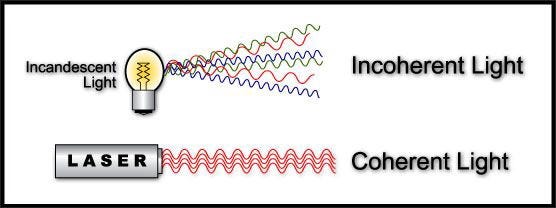
Another way to imagine this is like a pinball machine. Your typical copper wire contains all sorts of little impurities that act as pins. When the ball (electron) tries to move in a given direction, it is slowed down by the resistance posed by those pins. This is classical physics. Now imagine that instead of little pins getting in the way, the machine was full of Mario-Kart booster pads. When that little ball gets going fast enough, it stops behaving like a pinball and starts behaving like pure light. This is the beginning of quantum action.
“… trillions of electrons marching in lockstep, encountering no electrical resistance, gliding through metal without wasting any energy in the form of friction or heat.”
— Steven Strogatz, Sync: How Order Emerges From Chaos in the Universe, Nature, and Daily Life
As the current is moving freely, the magnetic field it creates will also exhibit special characteristics. A superconducting magnetic field cannot be interfered with by an imposing field. Instead, it will distort the interfering field around it. Because the electron clouds of every superconducting atom are resonating with one another, they form the cohesive Bose-Einstein condensate. Working together as a harmonized unicity, it cannot be penetrated by the infiltrating field. A superconductor will quite literally bend space-time around it. This impenetrable field is called the Meissner field (Diebner, 2021) (Figure 7).
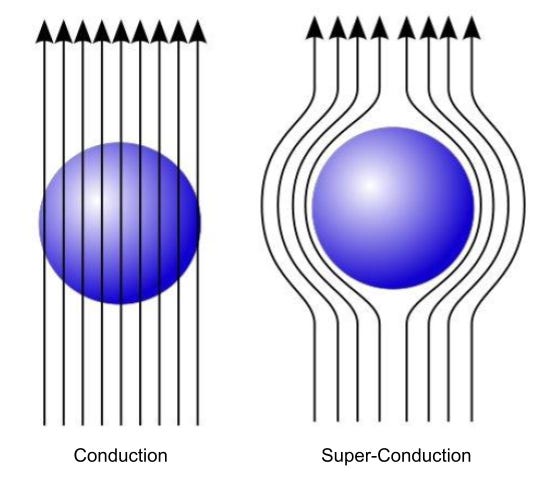
In order for a magnetic field to be energized to the point of becoming a Meissner field, the atoms of a semiconductor must harmonize in perfect quantum lock step. Typically, this only occurs when the temperature of the metal is cooled to near absolute zero. This reduces the vibration of atoms to such a degree that they begin to almost stop vibrating completely. Once the hum of vibrating atoms is quieted, the harmonization can begin.
Bringing this back into our physiology, the problem with super-conduction was that it was only believed to occur at extremely low temperatures. The atoms within a crystal lattice were thought to be too energetic at higher temperatures to support super-conduction. This was proven to be a poor assumption, however, in the late 1970s when Freeman Cope, a Navy biophysicist following Szent-Gyorgyi’s work, showed that super-conduction occurs at room temperature in a variety of living tissues. He demonstrated super-conduction in E.coli bacteria, frog and crayfish nerves, and molecules of RNA, among other animate matter (Becker, 1995). It is therefore possible that our living, functional anatomy is also capable of super-conduction.
Another Finish physicist named Matti Pitkanen has outlined a theoretical framework for superconductivity in living biological systems (Pitkanen, 2010). Moreover, a physicist at the University of Oslo in Norway has worked to develop a theory of superconductivity in the brain. He has theorized that the brain might be capable of superconducting at room temperature. The brain communicates via networked electrical connections, so the potential for highly coherent brain waves would imply the possibility of super-conduction, despite the high temperature (Mikheenko, 2018). The brain could function like an ordered crystal lattice.
“As a coherent quantum phenomenon, superconductivity could be responsible for coherent behavior of living organisms and even consciousness.”
— Pavlo Mikheenko (Mikheenko, 2018)
Although it may be yet unproven, the groundwork has been laid for the question of endogenous super-conduction to be answered. If endogenous super-conduction were possible, the conclusion would follow that we are capable of interacting with a quantum level of reality. The spooky action of Einstein and the harmonized electrons of Bose would become subjective reality, not just abstract theory.
The human brain, a super-bio-computer, as it were, is a parallel processor — a realizable artificial machine with this structure has not yet been built.”
— John C. Lilly, Programming and Metaprogramming in the Human Biocomputer (1972)
4. Modern Alchemy
4.1 Material Transmutation
“While working on his chemical experiments the operator had certain psychic experiences which appeared to him as the particular behavior of the chemical process.”
— Carl Jung, Psychology and Alchemy
In the mid-1970s, David Hudson was a farmer in the arid Arizona desert. The land at that time had such high sodium content that no water could penetrate the soil. It would crunch as he walked on it and was completely barren. To try and restore the land, he would pour truckloads of 93% sulfuric acid into the soil, drilling holes to penetrate deep below the surface. He always ensured that the soil contained rich calcium carbonate content, among other important minerals at the proper ratios (Hudson, 1990).
In essence, Hudson was taking care to enrich the ground with minerals and then subject the entire substrata to a vigorous exothermic acid-base reaction. This intense heat in the mineral-rich soil began to produce completely unknown rock formations. Upon refining this metallic product, he found a soft, fluid metal. Behaving much like liquid mercury at room temperature, he noted several odd characteristics of this fluid’s behavior and response to energy:
“You can flatten it out and make a pancake out of it. Yet this material shattered like glass. I said something’s going on here that we are not understanding. Something unusual is happening.”
“What happened was that after the material dried it exploded. It exploded like no explosion I had ever seen in my life and I’ve worked with a lot of explosive materials.”
“It was as if somebody had detonated about fifty thousand flash bulbs all at one time just poof.”
“This was not an explosion and was not an implosion. It was like a tremendous release of light.”
— David Hudson, 1990 Lecture Series
Hudson observed that when this material was left out in the Arizona sun to dry, it would detonate. After several experiments, however, he found that this detonation was not releasing force, but rather an immense amount of light. The explosion did not even have enough force to knock over a pencil standing on end, yet it looked like “fifty thousand flash bulbs” ignited at once (Hudson, 1990).
He proceeded to refine this unknown metal and found that it possessed strange electromagnetic properties as well. The element seemed to be superconducting at room temperature, creating the characteristic Meissner field.
Modern research has recently validated both this process and the resulting metal’s physical properties. A 2021 news article in Nature demonstrated this process in detail, even including a video clip of the transmutation (Figures 8 and 9) (Castelvecchi, 2021).


Almost any material can develop metallic properties if subjected to enough pressure (Castelvecchi, 2021). The researchers postulated, however, that a thin layer of metallic water could be created in a vacuum if it was sufficiently saturated with alkali metals that would readily donate electrons. Upon exposing a drop of the alkali metals to water vapor, it transformed. The result was the “formation of a transient gold-colored layer of a metallic water solution” (Mason, 2021).
The alkali metals used by Mason, et al., were sodium and potassium (Figure 10).
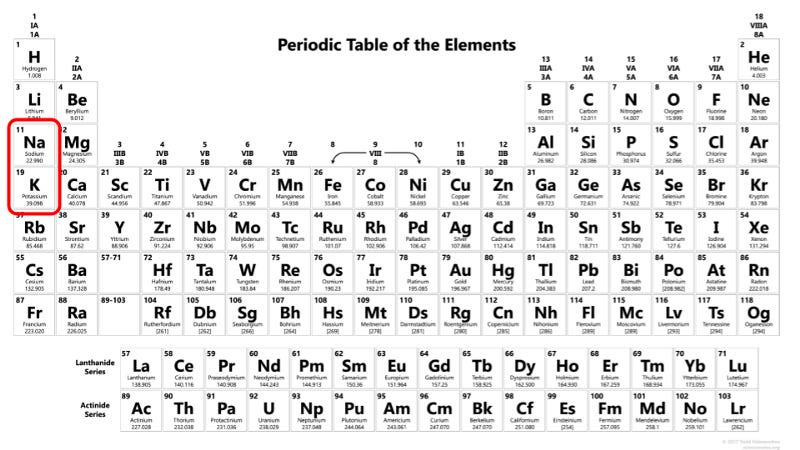
Sodium and potassium are known reducing agents, meaning they will readily donate their free electron. It appears that a variety of catalytic stimuli can initiate this transformation, as Hudson claims to have utilized an exothermic acid-base reaction to achieve the same end (Hudson, 1990). This in turn causes the water to undergo electrolysis, splitting to form hydrogen gas and oxygen. The hydrogen gas is then rapidly converted into metallic hydrogen with the dual influence of the alkali metals’ valence electrons and the electrical stimulus.
A team of physicists at the University of Rochester conducted a similar experiment to create this metallic hydrogen (Snider, 2020). Astonishingly, this team found that the metallic fluid was superconductive at much higher temperatures than is usually permissible (Castelvecchi, 2020). Recognized as the first true room-temperature superconductor, metallic hydrogen is incredibly mysterious. I will continue to refer to this strange fluid as metallic water, as this was the terminology used by Hudson, et al.
Taking these three reports together, it appears that when a solution of vital metals is energized in highly specific conditions, an alchemical transformation can occur. The result is metallic water: a superconducting, light emitting, mercurial fluid.
One important characteristic of this super-conducting metallic water is the property of superfluidity. There are very few superfluids that we know of today, liquid mercury and various isotopes of helium being among them. This metallic water is now another. When cooled to near absolute zero, these fluids will demonstrate this property. Once cooled to a critical temperature (which for metallic water seems to be unusually high), the friction between atoms becomes zero. Figure 11a demonstrates the Fountain Effect, as the the waves of electron orbitals of each individual atom in the fluid are perfectly synchronized. They begin to resonate in perfect harmony, a synchronized aggregate of trillions of atoms behaving as the Bose-Einstein condensate (Strogatz, 2003).
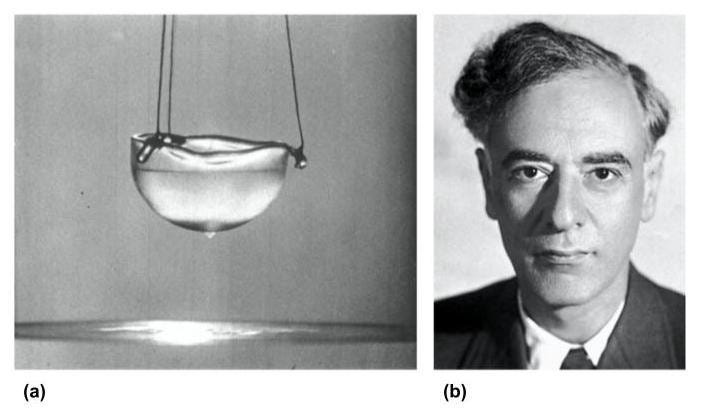
“Now scoop out a cupful of the superfluid and hold it upright, an inch over the bowl. Defying gravity, a solitary drop of fluid climbs up the inside wall of the cup, runs over the lid, and rains down into the bowl. As soon as it falls, another drop starts climbing. Like something out of science fiction, the superfluid pours itself back into the bowl, one drop at a time, until the cup is empty.”
— Steven Strogatz, Sync: How Order Emerges From Chaos in the Universe, Nature, and Daily Life
Atoms entrained into a superfluid mass will behave as if they are all one coherent particle. Just as the Meissner field can distort space-time around it, a superfluid can move against gravity with zero friction to preserve its atomic coherence.
Imagine a fluid so orderly that it moves against gravity to reconcile atoms cut off from the chorus, just to reestablish harmony.
“Suppose one of you has a hundred sheep and loses one of them. Doesn’t he leave the ninety-nine in the open country and go after the lost sheep until he finds it?”
— Luke 15:1–4
Superfluids will have zero viscosity due to to this complete lack of friction. Superfluid atoms will flow in a similar manner to superconductive electrons, unimpeded by friction or resistance. They will flow forever down a narrow capillary in perpetual motion (Yoksoulian, 2018). Atoms of superfluid liquid helium can fit through capillary gaps smaller than the atomic size of regular helium. This resembles the metaphor of quantum water tunneling through a brick wall. Superfluids become smaller and slippery as they reach super-conductance.
“The most spectacular signature of the transition of liquid 4He into the superfluid phase is the sudden onset of the ability to flow without apparent friction through capillaries so small that any ordinary liquid (including 4He itself above the lambda transition) would be clamped by its viscosity.”
— Anthony James Leggett, British-American low-temperature physicist, Nobel Prize laureate. Source
4.2 Psychological Transmutation
Returning to the mind of David Hudson, he knew upon discovering this metallic water that something extremely unusual was happening. Carl Jung suggested that the alchemical process was always akin to psychological realization of what he called the Self (Jung, 1953). David Hudson was no exception. He experienced a radical transformation of consciousness as a result of this experimentation. After seeing this mysterious metallic fluid explode in a heatless burst of light, he likened the process to a popcorn kernel popping to reveal a deeper truth within. He imagined the atoms themselves were, in a manner beyond simple allegory, flipping inside out.
“[Zen Buddhism] has a directness, verve, and humor, and a sense of both beauty and nonsense at once exasperating and delightful. But above all it has a way of being able to turn one’s mind inside out.”
— Alan Watts, The Way of Zen
In his subjective experience, he simply became aware as the atomic makeup of his atoms flipped from white noise to a symphony, from the perception of matter to the perception of energy, from the world of unique atoms to the world of Bose-Einstein condensate. All in an instant, he claims to have experienced superconducting consciousness (Hudson, 1990).
“A superconductor is billions and billions and billions of atoms all acting like one big macro atom. And so literally you make yourself a vessel that you can climb inside of that superconducts and you energize it and you exclude all external magnetic fields including gravity. And you are now in this world but you are not of this world. Hear me. In this world but not of this world.”
—David Hudson Lectures (1990)
Hudson is describing the Meissner field which cannot be influenced by external fields and is perpetually self-sufficient. A field which bends space-time around it. David Hudson is describing a personal experience of theoretical physics. A ride along with Mario in the pinball game.
Is superconducting consciousness possible? Alchemy is generally understood as a primitive predecessor to our modern chemistry. A dream to obtain the proverbial free lunch. The roots of this practice, however, are much more esoteric. History’s Hermeticists, who have followed the esoteric traditions laid out by the ancient alchemists, have claimed that states of altered consciousness are available to those initiated into the mysteries.
“Mind (as well as metals and elements) may be transmuted, from state to state; degree to degree; condition to condition; pole to pole; vibration to vibration. True Hermetic Transmutation is a mental art.”
— The Three Initiates, The Kybalion
Alchemy has been commonly believed to be “a process of chemical transformation [providing] numberless directions for its accomplishment.” (Jung, 1953). It is steeped in mythology and symbolism so rich, however, that it is impossible to reduce the alchemical process to mere chemical phenomena. Jung highlights this duality with a quote from an 18th century treatise on the alchemical process, the Abtala Jurain.
“A flame of fire will come out of the crucible and spread itself over the whole chamber (fear no harm), and will light up the whole chamber more brightly than the sun and moon, and over your heads you shall behold the whole firmament as it is in the starry heavens above.”
— Carl Jung, quoting from the Abtala Jurain (Psychology and Alchemy)
This is strikingly similar to the unknown geologic formation of Hudson, which he similarly describes as producing both a great explosion of light and strange psychological effects. Furthermore, it appears that this Philosopher’s Stone has been reproduced with the tools of our modern science (Castelvecchi, 2021). Both Hudson and Jung, among many others, have gone to great lengths to detail the overwhelming transformation of consciousness that emerges in response to the awareness of this mercurial fluid. Alchemy seems to be both a physical transmutation of mineral-rich reactant and a resulting shift in consciousness.
I believe that the two are one. It is possible that this alchemical gold, which has been projected into matter for thousands of years, could be brewed within the crucible of our own physiology. If we could create this superconducting, light emitting, mercurial fluid inside of ourselves, then it would certainly play some role in superconducting consciousness. The Hermeticists of the Kybalion just might have been speaking literally.
“This, in fact, is what is in your body that we call the consciousness … This is that part of your body that has been there all of this time, that scientists can’t find because their instruments can’t see it … And around your body you have a non polar magnetic field which is called the Meissner field or they refer to it as the aura. That literally these are the spirit atoms in your body. These are the atoms that are in resonant harmony and resonating with the vacuum energy. And the vacuum energy is another dimension where there is no time. Everything that ever existed and everything that ever will exist is registered in the vacuum. And I will tell you now, my friends, that when you meet your God, you will meet him in the vacuum.”
— David Hudson Lectures (1990)
“Yet time and space are but inverse measures of the force of the soul.”
— Ralph Waldo Emerson, The Over-Soul
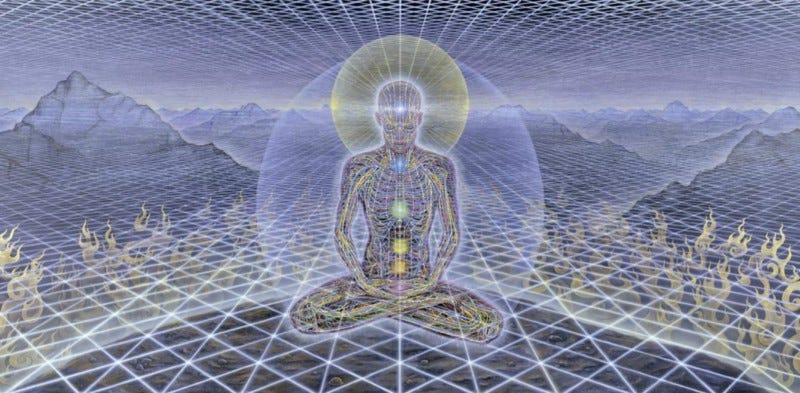
5. Waves of Cerebrospinal Fluid
5.1 Soaring Up
“This little wave of Prana which represents our own energies, mental and physical, is the nearest to us of all the waves of the infinite ocean of Prana. If we can succeed in controlling that little wave, then alone we can hope to control the whole of Prana. The Yogi who has done this gains perfection.”
— Swami Vivekananda, Raja Yoga
There is another piece to this puzzle which helps tie together our potentially superconducting physiology, rivers of light within us, and the alchemical transformation of mineral-rich fluid. That is the cerebrospinal fluid (CSF). The brain, and the entirety of the central nervous system (CNS), are awash in this colorless liquid. It acts as a shock absorber to protect our brains from impact with the skull, and helps in both providing nourishment to and removing toxins from our neural network.
This CNS is less like a bath, however, and more like an active, cyclic river. It flows with the rhythms of our breath and heartbeat. As I inhale, my sacrum bone extends backwards ever so slightly, opening up towards the small of my back. Simultaneously, the sutures of my skull open slightly, gently expanding the volume inside my skull cavity.
Then, as I exhale, my sacrum curls back under me and curls towards my perineum. My skull sutures also close and reunite, reducing the volume inside my skull cavity. These movements are incredibly subtle, so much so that during a normal respiratory pattern they go completely unnoticed (Dispenza, 2017).
It is as if, on the exhale, the skull is squeezed like a juice box and the CSF is pulsated down the spine. On the inhale, the base of your spine (known to yogis as the root chakra), then squeezes and lifts the energy subtly back up the spine into a skull that has opened to create a negative pressure gradient. It is an endless reciprocity, back and forth, as the fluid is pumped around the CNS. This flow occurs with every breath, taking approximately 12 hours for a single ion to make the complete loop (Dispenza, 2017). Figure 13 shows this process occurring in the brain.
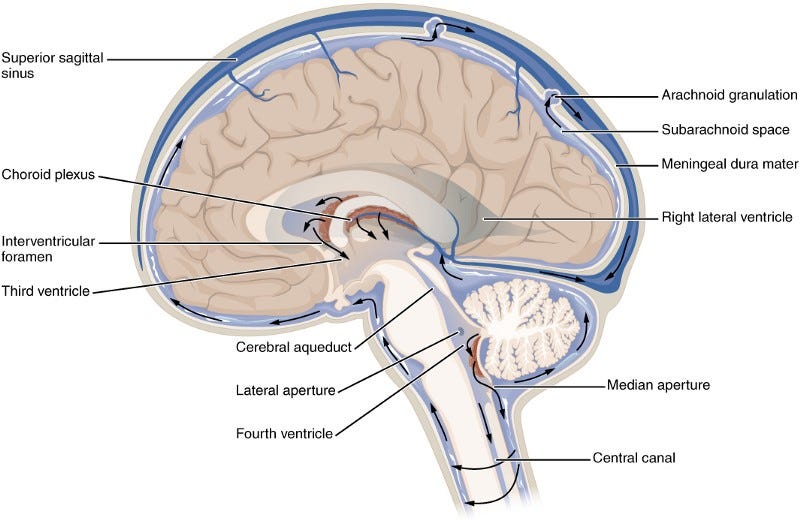
Mantak Chia, a modern day master of Taoist philosophy and healing practice, believes that the CSF is a part of our energetic body. He notes that the human body consists of two primary chi pumps: one at the sacrum, one at the cranium. These are precisely the two points at which the CSF reverses direction and begins the journey up/down the spine anew.
Outlining a series of stretches and breathing practices, Chia claims that anyone can begin to feel a warmth building in their spine. There is a slight pulsing that can be observed, if awareness is directed within the body, at the base of the sacrum and at the back of the neck (Chia, 2017).
“You feel the flow. That is what we call energy. It is the Chi flow.”
— Mantak Chia, London Real
These chi pumps correlate with the yogic bandhas. There are three primary bandhas: Mula bandha at the sacrum, Uddiyana bandha at the navel, and Jalandhara bandha at the throat/neck. These are energetic locks which are intended to send prana from the base chakras, up the spine, to the top of the head. These bandhas are key components of the yogic practice of Pranayama (prana, life-force; yama, to gain control).
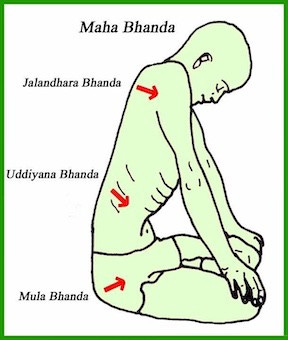
Figure 14 shows the three bandhas activated. Do a quick experiment: cross your eyes and try to see the tip of your nose. You might have noticed a little impulse travel down your spine and a feeling of elimination or contraction around the perineum. That is Mula bandha being subtly activated.
Imagine Mula bandha like a drawstring bag around the pelvis. The hip flexers, glutes, abdominals, and pelvic floor muscles all gently engage. They squeeze in and up, cinching the drawstring and pulling it up the spine. This initiates the pulsation of CSF up the spine (Swanson, 2019).
Uddiyana bandha is applied at the end of exhalation to expel all of the air out of the lungs. Uddiyana means soaring up, implying the rush of prana up the spine. You increase the pressure within the abdomen by squeezing the navel into the spine while the diaphragm pushes up into the rib cage (McConnell, 2016). This, in turn, increases what is known as the intrathecal pressure. This is the pressure within the subarachnoid space, that tube of tissue through which the CSF flows in the spine. By squeezing the juice box at the base of the body, the fluid shoots up the straw towards the head.
Jalandhara bandha, also known as the throat lock, serves to compress the cranial nerves running through the neck. This induces a trance-like state (McConnell, 2016). It activates the vagus nerve, leading to a parasympathetic response of the nervous system. This slow your heart rate and respiratory rate, calms down the mind, and guides the body into a sense of calm relaxation (Robin, 2002).
When these bandhas are activated and prana begins to circulate through the spinal column, the Sushumna nadi is activated. This is the axial meridian of our energetic system, running as a central column through the entire spine (Figure 15).
“The scientific method teaches a process enabling us to to draw to our central part — spine and brain — the life current distributed throughout the organs and other parts of the body. The process consists of magnetizing the spinal column and the brain, which contains the seven major centers, with the result that the distributed life electricity is drawn back to the original centers of discharge and is experienced in the form of light. In this state the spiritual Self can consciously free itself from its bodily and mental distractions.”
— Paramahansa Yogananda, The Science of Religion
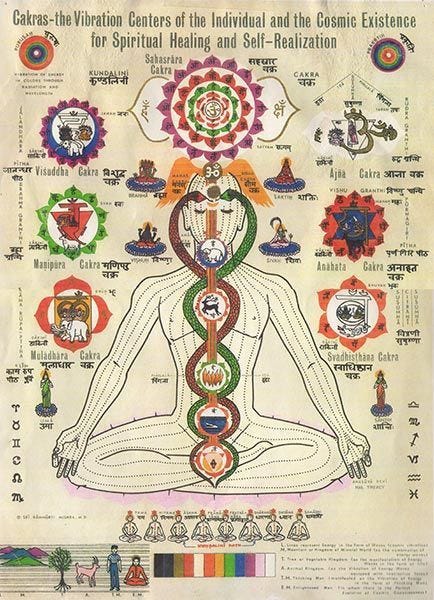
Dr. Selda Yildiz, a yoga instructor and PhD researcher at Oregon Health & Science University, recently developed a non-invasive phase-contrast MRI for recording the movement of CSF, measuring the exact velocity and direction of the fluid flow in real time (Yildiz, 2021). She hypothesized that various yogic breathing techniques might have significant effects on both heart rate and CSF flow velocity.
Incredibly, she has provided evidence that any individual who practices these yogic breathing techniques can reliably increase their cranial CSF velocities. She also demonstrates that these changes become more significant the deeper into our abdomens we breathe. Deep abdominal breathing, filling up the belly on the inhale, provided the most significant increase in CSF flow velocity (Yildiz, 2021). This has also been shown by Aktas, et al., who proved that belly-breathing leads to an increase in intra-thoracic and intra-abdominal pressure, which compresses the base of the subarachnoid space through which the CSF flows (Aktas, 2019).
“In the practice of the Complete Breath, during inhalation, the diaphragm contracts and exerts a gentle pressure upon the liver, stomachs, and other organs, which in connection with the rhythm of the lungs acts as a gentle massage of these organs and stimulates their actions, and encourages normal functioning. Each inhalation aids in this internal exercise, and assists in causing a normal circulation to the organs of nutrition and elimination. In High or Mid breathing the organs lose the benefit accruing from this internal massage.”
— Yogi Ramacharaka, The Hindu-Yogi Science of Breath
5.2 A Magnetic Axis
The chi pumps of Healing Tao and the bandhas of yoga have aimed to instill this ability to consciously increase the velocity of CSF flow.
If deep, slow abdominal breathing — the kind of breathing associated with a parasympathetic response — can result in an increase in the flow velocity of CSF, then what exactly is this CSF doing that correlates with a parasympathetic response?
Table 1 gives an overview of just some of the components of this rich fluid encapsulating our CNS (Spector, 2015). Of particular note are the ions.
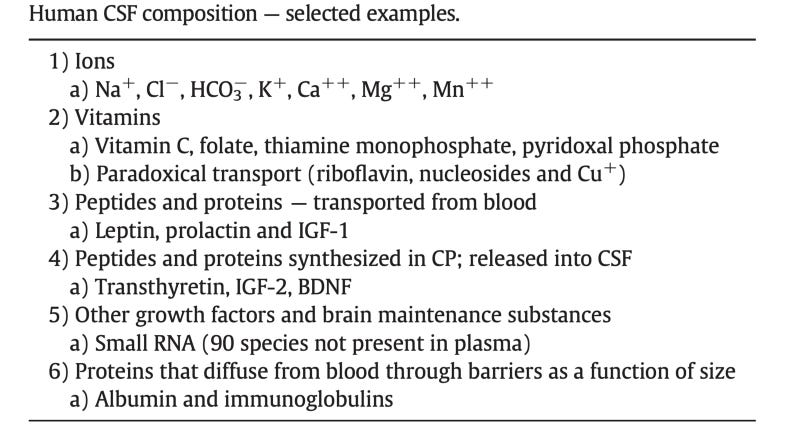
Sodium and potassium, specifically, were the two metals used by Mason, et al., to spontaneously generate the modern alchemical gold. Sodium and calcium carbonate were the minerals specifically listed by David Hudson as of vital importance in his soil. The CSF appears to be saturated with reducing agents, primed to donate electrons and create this alchemical gold.
I believe it could be possible, under highly specific conditions induced by yogic breathing practices, to create metallic water within the CSF. It has been shown that the body contains a vast network of circuits which are capable of semi-conduction, which could provide the required electrical stimulus to catalyze this transmutation.
Moreover, these ions all produce a charged solution. As the velocity of CSF flow increases, the entire loop of the CNS could act as a charge-carrying fluid. The entire spinal column would then be capable of creating a magnetic field around it. If metallic water is then spontaneously created, the CSF would become a superfluid. Zero boundary friction would exist between the flowing CSF and the intrathecal space. Just as charge-carriers can set up perpetual motion in a superconducting wire, superfluids can set up perpetual flow in a pipe. The faster the ions move, the larger the magnetic field produced. And if those atoms were superconducting, this would create the Meissner field (Figure 16).
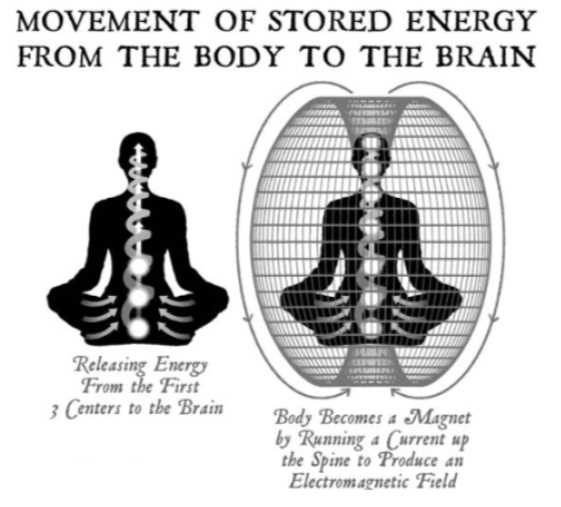
If the CSF could be transformed into metallic water, the entire spinal column would become magnetic. A superfluid, superconducting, magnetic river would course through the spine.
As conduction within this superfluid accelerates towards the speed of light, our natural magnetic field would begin to behave like the characteristic Meissner field. Our aura would expand around the Sushumna nadi. Pulsating electrical charges around the spine could create the heatless explosion of light which David Hudson described in 1990. The Abtala Jurain’s flame of fire, from which there is no need for fear of harm, would be ignited.
Looking from the perspective of the yogi, the CSF does not flow in this high energy state under normal circumstances because we have blocked our lower three energy centers. By repressing deep thoughts and acting in ways that sever connection with our communities, we choke the stream of consciousness.
“Many complexes are split off from consciousness because the [individual] preferred to get rid of them by repression.”
— Carl Jung, Psychology and Religion: West and East
This principle of emotional repression is a cornerstone of Chinese medicine, and is equivalent to the Jungian practice of confronting the shadow self. When we cut ourselves off from the stream of the universe, we wrap a tourniquet around our energetic body and are thus unable to resonate at these superconductive frequencies.
“Be the stream of the universe!
Being the stream of the universe,
ever true and unswerving,
become as a little child once more.”
— Lao Tzu, Tao Te Ching

6. Transcendental Experience
6.1 Kundalini and Quantum Tunneling
‘As soon as the life force (prana) flows into and up the central channel, it awakens the serpent power (kundalini-shakti) and pulls it into the central channel as well. Thereafter the kundalini rises to the crown of the head, leading to a sublime state of mind-transcending unified consciousness (or nirvakalpa-samadhi, “formless ecstasy”)’.
— George Feuerstein, The Deeper Dimension of Yoga
The rich symbolism of the Kundalini serpent can be traced back to Hermes Trismegistus, the renowned founder of alchemy. Just as yoga aims to transform the state of one’s consciousness, alchemy aimed to achieve a mental transmutation.
Considering the mythology, we can trace the Greek god of Hermes, the Egyptian god of Thoth, and the Roman god of Mercury back to the ancient legends of Hermes Trismegistus [(Ebeling, 2011), (Bull, 2018)].
Hermes of the Greeks is the messenger of the gods, a divine trickster who moves back and forth between the mortal world and the worlds of the divine. Mercury of the Romans is the guide for souls passing into the underworld and god of communication. Thoth of the Egyptians is the mediator between gods, the reconciling third who resolves conflict. All of these titles could be construed as metaphorical representations of the Kundalini’s action.
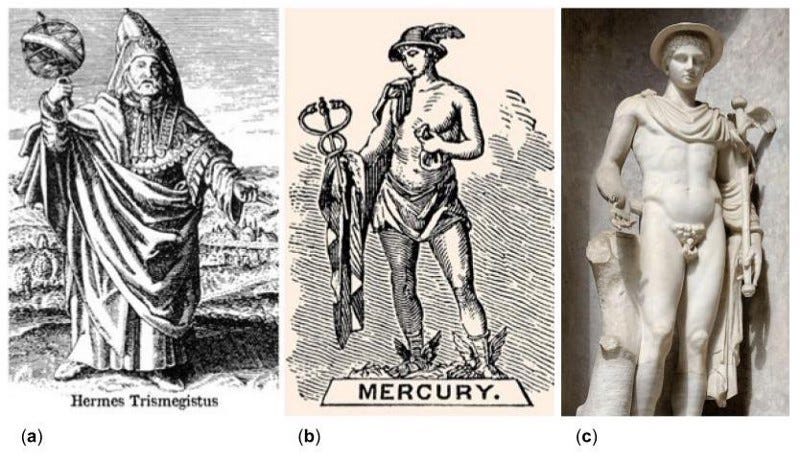
The staff which both Mercury and Hermes hold in Figures 18b and 18c is the symbol of the caduceus. The symbol depicts two snakes coiled around a central column, meeting together at the top. This is the Tantric Kundalini (Figure 15).
The Kundalini is depicted as two snakes coiled around the Sushumna channel. This central canal is thought of as the pathway of light, while the two in a revolving helix are thought to be the masculine and feminine aspects of this unicity. The possibility that superfluid metallic water could exist inside of this central channel allows a new understanding of this myth.
The masculine meridian is the Pingala channel. It is associated with rational thinking and is particularly stimulated on the exhale, twisting down the spine. Mythologically, this is the spirit of Shiva. Representing the divine masculine, Shiva is one of the three primary gods of Hindu lore (the other two being Brahma and Vishnu). He is the god of destruction, also known as “the Destroyer.”
His feminine counterpart is the Ida channel. It is associated with creative inspiration and is stimulated on the inhale, climbing up the spine. Corresponding with the spirit of Shakti, she is the supreme goddess. Shakti, translated literally, means power. She embodies the power of creation, beautifully juxtaposing the spirit of Shiva.
These two aspects of the Kundalini are said to lie dormant at the Muladhara, or root, chakra. Once stimulated, the Kundalini begins to stir. At a critical threshold of energy, the Kundalini bursts forth and rises through the five intermediate chakras, enlivening them with prana as it passes through. These channels then re-converge at the Ajna chakra, or the mythic third eye. This is said to be the divine consummation, the ultimate reconciliation of Shiva and Shakti in the cosmic dance (Figure 19).

“The columns of sensory and motor fibers in the spinal cord are the Ida and Pingala of the Yogis. They are the main channels through which the afferent and efferent currents travel.”
— Swami Vivekananda, Raja Yoga
Figure 20 shows the various bundles of myelinated nerve fibers in the white matter of the spinal cord. The gray matter, in the butterfly shape at the center of the column, contains unmyelinated nerve cells. The white matter, however, is rich with myelin. Recall that it is precisely this myelination that Dr. Becker discovered was the conduit for our semiconducting DC currents. The spinal cord contains two classes of myelinated neurons: afferent (sensory), and efferent (motor).
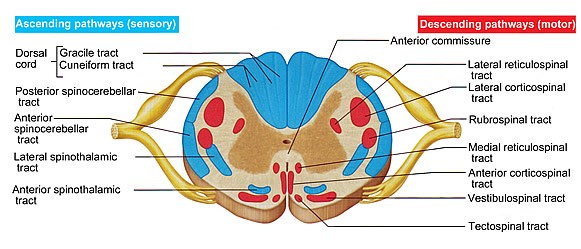
The sensory neurons send information about what is happening in the body up to the brain while the motor neurons send information down to the body as instructions. They are a system of antiparallel tubes in semi-conduction, winding their way up and down the spine as fiber optic cables.
What then would happen if we assumed the possibility of super-conduction in these myelinated channels?
Recall the work of Dr. Brian Josephson and his discovery of the Josephson junctions (Section 3.1). When two superconductors are placed in close proximity to one another with an insulating barrier between, a super-current is created through that insulation. It does this by creating Cooper pairs. Tunneling back and forth through the insulator, these energetic charge-carriers entrain both the insulator and the conductors into a harmonious channel of electromagnetism.
If this were possible in our spines, the fractal beauty would be magnificent. The Pingala and Ida channels would consummate to form a unicity. Meanwhile, electrons would form mate pairs, beginning to act as harmonized energy rather than dense matter. Shiva and Shakti would dance together at the subatomic scale.
Furthermore, Josephson junctions are capable of interacting with a property known as ferromagnetism. If a magnetic substance is close enough to the Josephson junction to be electromagnetically synchronized, then Cooper pairs will bring that external magnetic substance into harmony. Super-conduction would then be established in the magnetic channel outside of the two superconducting pathways (Ryazanov, 2001).
If the CSF surrounding the Ida and Pingala channels were to be transmuted into a superfluid metallic water, this would certainly be capable of ferromagnetism. Cooper pairs tunneling between the ascending and descending myelin would interact with the metallic water, bringing the CSF into resonance with the ascending Kundalini. The superconducting Ida and Pingala would then be pulled into the central channel as well.
Finally, these motor and sensory pathways of the spine run antiparallel; one runs up while the other runs down. If we consider the possibility of Cooper pairs tunneling through the grey matter of the spinal cord, these electrons would resemble the rungs of a twisted ladder. This is precisely the geometrical pattern seen in the DNA double helix (Figure 21). The Ida and Pingala would be like the sugar-phosphate backbone of a DNA molecule, with the tunneling Cooper pairs resembling paired nitrogenous bases.
“He had a dream in which he saw a stairway resting on the earth, with its top reaching to heaven, and the angels of God were ascending and descending on it.”
— Genesis 28:12, Jacob’s Ladder
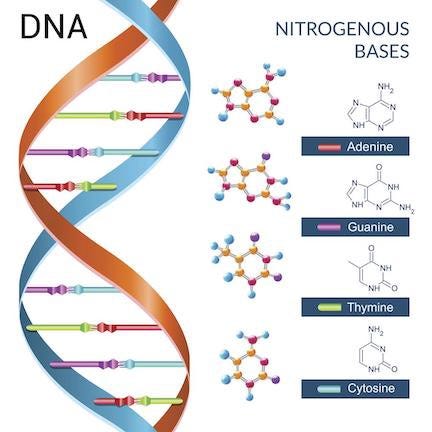
There is a special kind of Josephson junction known as a Pi Josephson junction. This can occur when a Josephson junction is entrained with a ferromagnetic substance, and/or when the two superconducting wires are shorted [(Ryazanov, 2001), (Kontos, 2002)].
When the two wires of a Josephson junction (usually separated by an insulating layer) are suddenly connected, the circuit is shorted. The superconducting current begins to run in an unbroken loop, possessing infinite energy as it circulates in perpetual motion. This circuit is instantaneously formed at the moment the two divided channels are united.
“Instantly a tremendous sensation ensues in the spine, as if hundreds of [volts] of electrical current is flowing through it. The sensation begins from the coccyx and rushes towards the brain, where it becomes fixed in the Ajna chakra.”
— Brahmachari Animananda Dharmacharya, quoted in Letters from the Yoga Masters
Our Ajna chakra is our mystical third eye. Here, the Ida and Pingala unite (Figure 15). This effectively shorts the afferent and efferent nervous bundles of the spine, creating the Pi Josephson junction.
6.2 Your Ajna Chakra
‘Brahma thought for a long time and then said, “Here is what we will do. We will hide their divinity deep in the center of their own being, for humans will never think to look for it there.”’
— Hindu legend (Source)
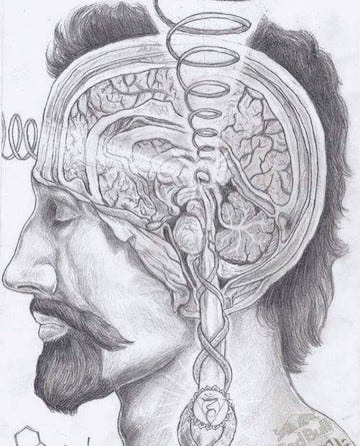
This mythical chakra is related with the pineal gland. Renes Descartes is famously known to have referred to the pineal gland as the seat of the soul (Abhyankar, 2020).
Your pineal gland’s role is to modulate melatonin levels in accordance with your circadian rhythm. It produces the enzyme to convert serotonin into melatonin, however it only does this during the dark part of the circadian cycle (Aulina, 2019). In the light of day, melatonin production is radically inhibited (Lucas, 1999) (Figure 23). The pineal gland is designed to efficiently convert the amino acid tryptophan into the molecules of serotonin and melatonin. The pineal gland also produces a plethora of other enzymes which are capable of concocting far stranger molecules.
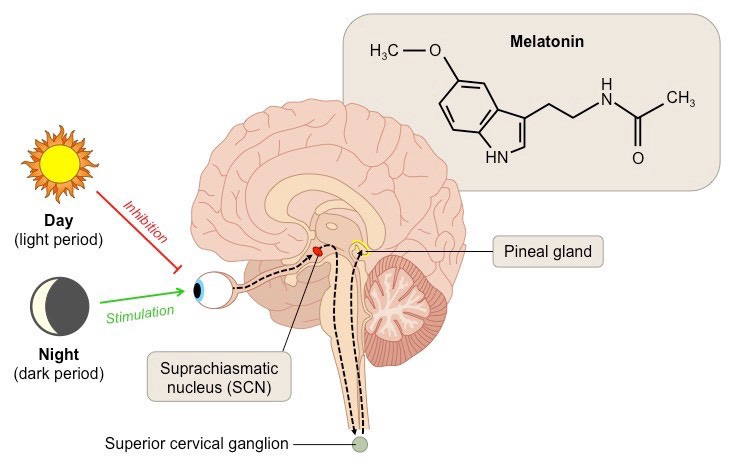
Under proper conditions, the pineal gland is capable of converting melatonin into the following:
Benzodiazapines
A phosphorescent bioluminescent molecule (5-methoxylated indoleamine)
A host of powerful antioxidant, anti-inflammarory, and immuno-modulary drugs
Beta-carbolines
N, N-Dimethyltryptamine (DMT)
While we know that the pineal gland is capable of making all of these things, we do not know why. Under normal physiological conditions, the pineal gland does not have the energy to make these energetically expensive molecules [(Dispenza, 2017), (Strassman, 2001)]. These chemicals which the pineal gland possesses the abilities to create, but not the energy, are beautifully synchronistic.
Benzodiazepines are depressants, slowing down the executive mind and quieting analytical thoughts (ego). These are known to reduce activity in the amygdala, the part of the brain responsible for the fear response. Coupled with the parasympathetic nervous response brought on by sustained deep abdominal breathing, this is a powerful combination for bringing the body deeper into a highly relaxed, stable-energy state (Dispenza, 2017).
A bioluminescent molecule created out of one of the most orderly structures in the body warrants a double take. The pineal gland contains rod and cone cells, identical to those found in your eyes. Despite being buried deep in the skull, this gland has the capability to function as an inward-pointing eye, swimming in CSF. If bioluminescence, or any light, is emitted into this fluid, it could be perceived by the pineal gland. It could be an actual eye (Li, 2012).
The pineal gland can also convert melatonin into a number of incredibly restorative antioxidant, anti-inflammarory, and immuno-modulary molecules. These flood the brain and circulatory system with the body’s own supply of exactly the cocktail of drugs it needs to heal (Hardeland, 2008). The pineal gland provides you with an endogenous pharmaceutical factory, restoring your body to health. All it needs is sufficient energy to catalyze these reactions.
Beta-carbolines stop your body from breaking down hallucinogenic chemicals. They do this by inhibiting the monoamine oxidase enzymes (MAOs). This class of enzyme breaks down tryptamine molecules in the CNS. These tryptamines include both serotonin and melatonin, but also a range of the classical psychedelics including psilocybin (the active chemical in magic mushrooms) and DMT (Pollan, 2018) (Figure 24). These are some of the most potent hallucinogens.
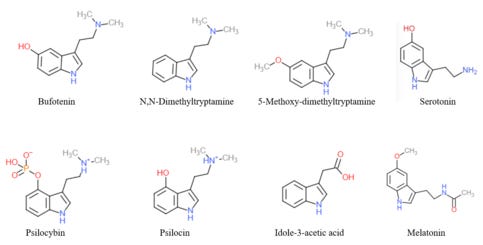
By releasing beta-carbolines directly into the CSF, the body is allowing these hallucinogens to stick around. The body knows that if you are speeding down the highway or running away from a lion (sympathetic nervous response, fight or flight), it would be a bad time to be immersed in fractals. So in those cases, monoamine oxidase enzymes rapidly eat up the tryptamines. But once the body gets the signal that it is safe, triggered by a parasympathetic response, the analytical mind shuts down and the body grows still. The body now feels that it is safe enough to open pandoras’ box. Once resistance is released, the hallucinogens are allowed to have their effects and the body stops breaking them down.
It is worth noting that these beta-carbolines are the same molecules that make the South American shamanic brew of Ayahuasca so potent. This is a ritual blend of two plants, one of which contains the molecule DMT while the other contains various beta-carboline alkaloids. This makes the brew orally active because the body stops breaking down the DMT. It seems that, similar to the alchemy of Hermeticism, shamanic traditions have maintained methods of producing in the world what our bodies so beautifully make within. The question of how amazonian tribes would have known to combine these two particular plants remains a mystery.
Finally, the brain produces DMT. We do not know for sure whether it is the pineal gland or some other region within the CNS that synthesizes it. Regardless, it is clear that DMT is produced endogenously and that the pineal gland contains the necessary enzymes to make this happen (Dean, 2019). Why exactly the body would spend such energy producing a powerful hallucinogen, and why it protects the CSF from its effects normally, is another mystery.
“Tell me how you make illegal
Something that we all make in our brain
Some say you might go crazy
But then again, it might make you go sane”
— Sturgill Simpson, Turtles All the Way Down
The pineal gland is capable of producing all of these miraculous gifts of healing; what it lacks is energy.
As the Sushumna channel is energized, however, it receives this energy in the form of waves of CSF pulsing across its surface. The unique position of the pineal gland allows it to be in direct contact with this CSF flow running across it. Figure 25 was curated by Celine Legros (Legros, 2014). She showed that melatonin is spread to the brain by diffusing into the CSF and then being washed over all of the brains’ crevices. She also provided an intricate map of the trajectories which melatonin takes upon being released from the pineal gland of sheep. It is reasonable to assume other metabolites of the pineal gland would follow the same trajectory, being washed all over the brain.
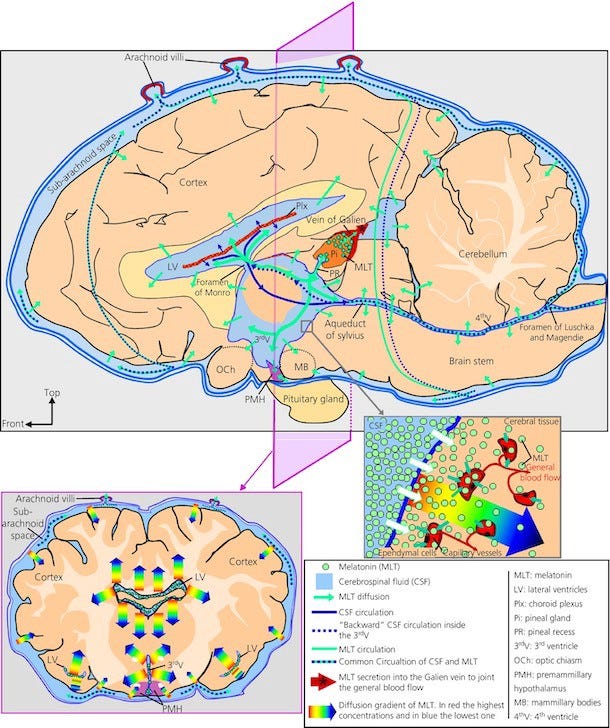
The pineal gland has two astonishing features, beyond its exorbitant pharmaceutical production.
The pineal gland is covered with little cilia (latin for eyelashes) which stick out and float in the CSF. These hairs are stimulated by intracranial CSF acceleration through the third ventricle. Fast moving fluid in the CSF tickles the pineal via these cilia, overstimulating it (Dispenza, 2017).
The pineal gland is largely a mass of piezoelectric calcite microcrystals. Piezoelectric (Greek piezen, to press, and piezo, to push) charges occur when microcrystals are squeezed and compressed, emitting an electrical charge from the crystal lattice (Baconnier, 2002). This mass of crystals on the pineal gland is capable of vibrating at higher frequencies of energy due to its geometrically symmetrical crystal lattice. In doing so, it discharges an electric spark.
As the bandhas are engaged and the breath is directed into the bottom of the lungs, the intrathecal pressure grows and CSF is pushed up into the brain. The piezoelectric calcite microcrystals would emit a flash of charge in response. This spark of electricity would then be diffused into the surrounding CSF.
This flash of energy at the pineal gland occurs in response to physical stimulation. Given the position of the pineal gland within the river of CSF, dramatic changes in intrathecal pressure could very well cause this stimulation. It would result in a discharge of light and energy and a release of various chemicals into the brain. An orgasmic release in response to the consummation of Shiva and Shakti.
Imagine a flash of piezoelectric-induced charge emitting out like a beacon through the CSF. This would act as a massive shock, like a defibrillator jumpstarting a heart back into rhythm. An enormous pulse of energy would course through the system, entraining every individual into the beat of the chorus. The superconducting currents would be shorted, and the Kundalini would be pulled into the ferromagnetic CSF. It would all act as a single channel of energy.
All the while, the photoreceptors of the pineal peer out into the darkness of the CSF, eagerly awaiting the light to come. In this moment of orgasmic release, the piezoelectric spark could ignite in the metallic river of CSF. The internal flame of fire will have been ignited.
“With the strength of his spiritual eye and insight grows distance and, as it were, the space around man: his world becomes more profound; ever new stars, ever new riddles and images become visible for him.”
— Friedrich Neitzche, Beyond Good and Evil
Hermes Trismegistus, the legendary founder of alchemy and master of superfluid transmutation, evolved into the gods of Mercury and Hermes. As god of protection and spirit communication, he holds the key for our personal experience of superconducting consciousness. Adorning the crown of his caduceus is a pinecone. Two serpents coil around a central channel in a double-helical pattern, merging together as one at a pinea (latin, translated pinecone) (Figure 26).
“The light of the body is the eye; if therefore thine eye be single, thy whole body shall be full of light.”
— Matthew 6:22
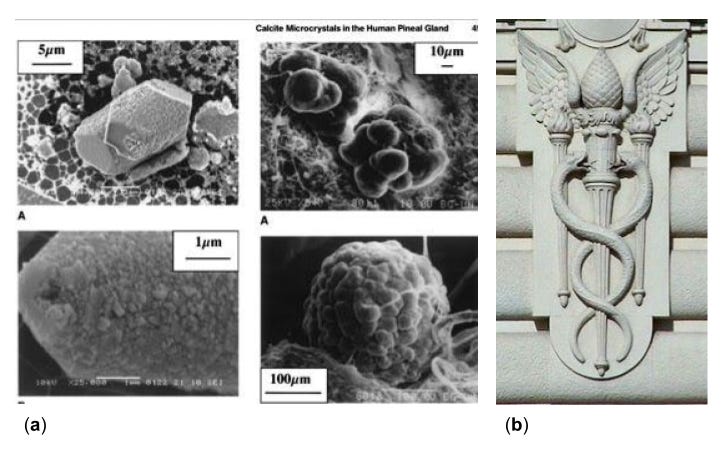
The key which Mercury holds is that which lies in our own spine. He is telling us to look inside of ourselves.
A concoction of benzodiazepines, beta-carbolines, DMT, and a whole spread of healing drugs would be released into the CSF, diffusing directly into the visual, auditory, and emotional centers of the brain which sit in close proximity (Strassman, 2002). From the blank canvas of engulfing light, a flood of self-made hallucinogens would begin to shift awareness into entirely new realms. These realms could be the same states of awareness described by David Hudson and the alchemists of history.
6.3 The Psychonaut’s Journey
“[DMT] occurs as a part of ordinary human neurometabolism and is the most powerful of the natural occurring indole hallucinogens. The extraordinary ease with which DMT utterly destroys all boundaries and conveys one into an impossible-to-anticipate and compellingly Other dimension is one of the miracles of life itself.”
— Terence McKenna, Food of the Gods: The Search for the Original Tree of Knowledge
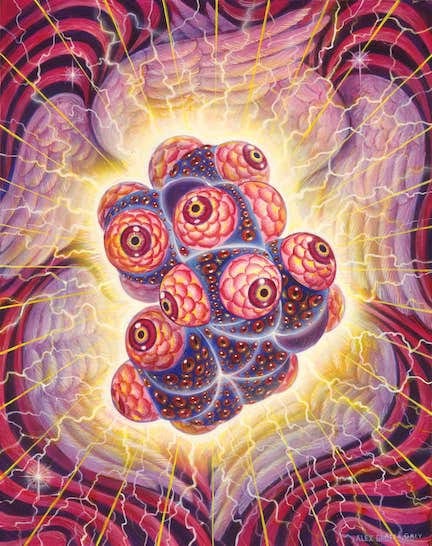
The word psychedelic was not coined until 1957, however consciousness-altering medicines have been a part of human experience tracing back to the primitive shaman’s mushroom cave paintings. The sacred use of these plant medicines can be traced through the entire history of religion (Muraresku, 2020). The term is derived from the greek psyche (soul) and deloun (to make visible). Thus, the term psychedelic can be translated literally as making the soul visible.
Dr. Rick Strassman was the first American allowed to research psychedelics after their broad classification as Schedule 1 drugs in 1970. He offered intravenous DMT to volunteers in a controlled, comfortable setting where they were encouraged to explore internal experiences. The most common experience was that of intense energy coursing through their bodies, unlike anything the volunteers had ever experienced.
‘Nearly everyone remarked on the “vibrations” brought on by DMT, the sense of powerful energy pulsing through them at a very rapid and high frequency.’
— Rick Strassman, DMT: The Spirit Molecule
One particular patient who participated in this study was a thirty-nine year old medical social worker. Her description of the experience is strikingly similar to the reports of unbeknownst alchemist David Hudson (Strassman, 2002).
“The other side is very, very different. There are no words, body, or sounds there to limit things. I first saw deep space, white with stars. Then there was this multidimensional experience starting.”
— Anonymous volunteer from Rick Strassman’s experiment, DMT: The Spirit Molecule
This conception of an other side presents us with our deepest metaphysical uncertainties. Could it be an achievable state of consciousness here and now? The yogis, mystics, alchemists, quantum physicists, religious icons, and psychedelic explorers (self-named psychonauts) seem to advocate for this possibility.
Dr. Strassman’s pioneering work has inspired a new wave of legitimate medical research into psychedelics. The Center for Psychedelic and Consciousness Research at Johns Hopkins, led by Dr. Roland Griffiths, is spearheading this exploration.
Dr. Griffiths has studied the experience induced by psilocybin mushrooms, a classical psychedelic which radically influences one’s perception of reality in a mechanism similar to endogenous DMT. He gave 36 well-educated, hallucinogen-naive volunteers a large dose of psilocybin and compared their experiences. He was shocked by his own conclusion.
“It is remarkable that 67% of the volunteers rated the experience with psilocybin to be either the single most meaningful experience of his or her life or among the top five most meaningful experiences of his or her life… the volunteers judged the meaningfulness of the experience to be similar, for example, to the birth of a first child or the death of a parent.”
— Roland Griffiths, (Griffiths, 2006)
He has continued this work, offering psilocybin to 51 cancer patients with a terminal diagnosis. Suffering from extreme death-anxiety and depression, these patients volunteered in hopes they might find some peace in light of their circumstance. Dr. Griffiths found that after a single high-dose psychedelic experience, these patients reported large and significant decreases in depression, anxiety, and fear of death (Griffiths, 2016). Dr. Robin Carhart-Harris at the Imperial College of London has done similar work, showing that psilocybin can be a highly effective remedy for treatment-resistant depression after just a single experience (Carhart-Harris, 2016).
This work poses an extremely important question: are the drugs producing these radical effects, or is it some inner experience which the drugs facilitate? Attempting to answer this, Dr. Griffiths conducted a study to compare mystical experiences induced by classical psychedelics (DMT, LSD, or psilocybin mushrooms) and those occurring naturally. He found that both psychedelic-induced and naturally occurring mystical experiences had the same subjective components, the same transformative power, and the same numinous quality (the feeling of being more real than real). The only significant difference between the two groups was the words used to describe the experience.
“If two experiences are phenomenologically indistinguishable, it cannot be concluded that one is genuine but the other is not.”
— Roland Griffiths, (Griffiths, 2019)
Additionally, Dr. Griffiths and others have shown statistically that the positive behavioral changes occur most prominently in those patients who had the deepest mystical experiences. There seems to be a strong correlation between the subjective experience and the extent to which healing can occur [(Pollan, 2018), (Griffiths, 2019), (Fadiman, 2011)].
‘Religious experience is absolute; it cannot be disputed. You can only say that you have never had such an experience, whereupon your opponent will reply: “Sorry, I have.” … No matter what the world thinks about religious experience, the one who has it possesses a great treasure, a thing that has become for him a source of life, meaning, and beauty, that has given a new splendor to the world and to mankind.’
— Carl Jung, Psychology and Religion
Psychedelic medicine stands at a precipice, posed to revolutionize the medical field of psychiatry within the next decade. Before psychedelic research was abolished in 1970, however, there was an eclectic group of researchers who were effectively using psychedelics in psychiatry throughout the 1960s. Timothy Leary, studying LSD at Harvard with Richard Alpert (otherwise known as Baba Ram Dass), threw these medicines into the counter-culture movement and corrupted them with his call to Tune In, Turn On, Drop Out. The cultural cataclysm which ensued created such fear that these medicines were promptly classified as Schedule 1 narcotics (Pollan, 2018).
“Tune in, ok. Turn on, ok. Be better! … All the heroes who come back from that journey share what they have with the community and integrate it. It is the opposite of dropping out.”
— Jordan Peterson, The Joe Rogan Experience #1769
Prior to the upheaval of the late 1960s, however, psychedelics were viewed as a miracle in psychiatry. LSD was considered a “wonder drug” by the American Psychiatric Association. By the early 1950s, it was being effectively used to treat addiction, depression, obsessive-compulsive disorder, schizophrenia, autism, and end-of-life anxiety. The founder of Alcoholics Anonymous, Bill Wilson, credited his own sobriety to a mystical experience on the hallucinogenic belladonna (Pollan, 2018).
After this research came to an abrupt end in 1970, many of the leaders in psychiatry went on to study other methods of inducing these profound experiences. Dr. Stanislav Grof had been one of the worlds most prominent researcher in LSD’s application to psychotherapy. He offered LSD to numerous patients in a controlled, clinical setting as a part of his psychiatric practice. Recounting his own experience on LSD, Dr. Grof said the following:
“There was this incredible flash of light, beyond anything that I could even imagine… My consciousness was catapulted out of my body. I lost the research assistant, I lost the clinic, I lost Prague, and then I lost the planet. I had a sense that my consciousness had absolutely no boundaries, and I had become all of existence.”
— Stanislav Grof, quoted in Higher Wisdom: Eminent Elders Explore the Continuing Impact of Psychedelics
Dr. Grof went on to develop Holotropic Breathwork. He defined this as a combination of “accelerated breathing, evocative music, and a technique of bodywork that helps to release residual bioenergetic blocks” (Grof, 2010). He adopted much of his technique out of the yogic practice of Pranayama, while adding insights from his work with LSD. He found that he could reliably induce these mystical states of consciousness in patients with sustained practice, and that those experiences were shockingly similar to the ones he had experienced with LSD.
Richard Alpert, Timothy Leary’s partner at Harvard, traveled to India to try and map out this inner-world of psychedelics. He took a vial of LSD with him, hoping to meet someone who could explain these profound experiences through the lens of Eastern spirituality. While in India, Dr. Alpert met the Hindu guru Neem Karoli Baba (also known as Maharaj-ji) (Figure 28).
After presenting the LSD, Maharaj-ji reached out and took the equivalent of fifteen doses. To the shock of Dr. Alpert, absolutely nothing happened to this sage’s demeanor. He just smiled, acknowledging what he called the yogi medicine. The same drug which had caused Dr. Grof’s consciousness to be catapulted out of his body had no effect on this holy man of India. Having witnessed this, Dr. Alpert stayed in India for many years studying yoga and adopting the name Baba Ram Dass (meaning Servant of God) (Ram Dass, 1978).
“For a person deeply attached to any finite reality which he takes to be absolute, the psychedelics can, under proper conditions, help him to break out of the imprisoning model created by his own mind. Of course, there is a paradox here: if he wants to take a psychedelic in order to break out, he already knows of another possibility… and thus could proceed without the psychedelics.”
— Ram Dass, Be Here Now

Spiritual teachers such as Ram Dass and the modern research of Dr. Griffiths both demonstrate that while psychedelics can be one method of achieving mystical states of consciousness, they are by no means necessary. In fact, evidence clearly suggests that this experience is possible with no exogenous input at all. Any number of methods are capable of producing these states of superconducting consciousness. The scientific reality of endogenous DMT, paired with a collection of traditions teaching how it can be induced, bring life to the idea of drug-free mystical experience.
The psychological influence of psychedelic drugs is, by all credible reports, phenomenologically the same as the influence of metallic water on the alchemist’s psyche. It also seems that, just like the mental transmutation of Hermeticism, our own pineal gland could produce the same molecule which psychonauts use to explore these inner-realms of consciousness. The exogenous rituals and practices of history, where the drug or metal was projected outside of the body, might have an endogenous counterpart.
Whatever the method, the results are all phenomenologically the same.
7. All in All
“Our normal waking consciousness is but one special type of consciousness, whilst all about it, parted by the filmiest of screens, there lie potential forms of consciousness entirely different. We may go through life without suspecting their existence, but apply the requisite stimulus and at a touch they are there in all their completeness.”
— William James, The Varieties of Religious Experience (1982)
Carl Jung acknowledged in 1932 that we had not yet found the bridge between physics and psychology. The last 90 years, however, have radically changed our world.
On one side of this bridge is natural science. Experimental physics, coupled with an understanding of our electrical bodies, is beginning to reveal how our world actually functions. The scientific method has propelled us into a world of unimaginable innovation, where even the wildest of theories can be tested.
On the other side of this bridge is subjective experience. The depth of your psychology is wholly dependent on how far you are willing to explore; your mind is infinitely deep. While the scientific method is an incredible tool for generalizing about our world, its authority cannot extend into your personal experience. For that, you are on your own. Yoga, for thousands of years, has been a practice designed to carry the practitioner into his or her own psyche. It is nothing more than a method of exploring your own consciousness.
“In the course of the centuries the West will produce its own yoga, and it will be on the basis laid down by Christianity.”
— Carl Jung, The Psychology of Kundalini Yoga
I do not intend to dispel a belief system. The theories I have proposed can and should be experimentally tested with the scientific method. That necessity, however, does not invalidate the other side of this bridge. You can plunge into the depth of your own psyche, and see for yourself what you believe. If superconducting consciousness is possible, then it is possible for us all.
In this light, I have outlined my closest estimation for how superconducting consciousness can be experienced.
You should sit down, spine erect but comfortable, and begin to feel your physical body melt into the ground. Imagine the substrate of your physical body becoming silent. No atoms are vibrating individually; they begin to buzz together. There is nothing that needs to actively be done in order for this to happen, simply become aware as you begin to feel it happen of its own accord.
This might feel like a slight tingling or vibration, or a ghost limb that has fallen asleep. You might feel uneasiness, turbulence, or physical sensations such as cramping. It is best to relax into these sensations rather than fight against them. Instead of reacting to the feeling with a movement, look more closely. Be curious and inquire about the sensation instead. It is from this place of stillness that super-conduction would be possible. Once the baseline level of synchronization has been reached, the electron velocity can be stimulated.
As you practice yogic breathing, you squeeze the subarachnoid space at the bottom of the spine. This pumps the CSF to begin cycling around the spine and through the brain. Once the CSF has been sufficiently stirred, the yogi can relax back into passive awareness. You watch as the breath begins to fill the deep lungs and lower abdomen, filling up the belly. This practice continues until it is happening automatically in the background of your awareness.
‘The Yogi bases his rhythmic time upon a unit corresponding with the beat of his heart. The heart beat varies in different persons, but the heart beat unit of each person is the proper rhythmic standard for that particular individual in his rhythmic breathing. Ascertain your normal heart beat by placing your fingers over your pulse, and then count: “1, 2, 3, 4, 5, 6; 1, 2, 3, 4, 5, 6,” etc. until the rhythm becomes firmly fixed in your mind. A little practice will fix the rhythm, so that you will be easily able to reproduce it. The beginner usually inhales in about six pulse units, but he will able to greatly increase this by practice.’
— Yogi Ramacharaka, The Hindu-Yogi Science of Breath
This is the goal for all yogis and yoginis. To allow this deep, rhythmic, belly-filling breath to be the sole point of attention. There is nothing else to do. As this process is deepened, the energetic vibrations coursing through our rivers of light grows stronger. Trapped into lock step harmony, they continue to accelerate. At a certain point, sufficient energy is reached for Kundalini to be stirred. This crescendo of energy breaks apart the clods of repressed energy like a vortex of wind blowing leaves from a tree.
As the afferent and efferent pathways of the spinal cord’s white matter join in with the harmony, they climb up the spine and unite at the Ajna chakra. This consummation of male and female creates a short in the superconducting meridians of the spine. Instantaneously, the Josephson junction wrapped in a double-helical pattern around the spine is linked into a single loop of energy.
One backbone of the helix draws prana up the spine, the other tracks it back down. They run antiparallel while entrained in Cooper pairs. The CSF becomes entrained to the sync of tunneling Cooper pairs and achieves the state of superfluidity. The entire spinal column functions as a single magnetic axis, drawing energy up and through it. The atoms of superfluid metallic water in the CSF are tuned to the exact same dance as the Ida and Pingala meridians.
The rapid pulse of CSF into the brain flows across the surface of the pineal gland, tickling it to induce a piezoelectric spark. This spark ignites the alchemical brew of metallic water flooding the pineal. Suddenly, light envelops everything. The photoreceptors of the pineal gland are blinded by the internal flame of fire. In response to this blinding internal light, the pineal gland rapidly converts tryptamine into the concoction of healing molecules, beta-carbolines, and DMT.
These psychedelic jewels are released directly to the visual, auditory, and emotional centers of the brain. Like a projected image onto the white canvas of a movie screen, the yogi’s inner experience becomes reality.
Our neurophysiology is built around a single axis: the breath. We become aware of the breath; we steady the breath; we deepen the breath. We love the breath. Everything else happens to us. We allow ourselves to be swept off, cast into an oblivion of superconducting energy. By surrendering into the harmony, we can let go of the illusion that we are isolated matter and accept our place in sync with harmonious energy.
“Counting stars by candlelight
all are dim but one is bright
The spiral light of Venus
rising first and shining best
On, from the northwest corner
of a brand new crescent moon
While crickets and cicadas sing
a rare and different tune
Terrapin station”
— The Grateful Dead, Terrapin Station
8. References
Abhyankar, Rahul. (2020). On the Seat of the Soul: Descartes’ Pineal Gland. Neurology, 94, 5. DOI: https://n.neurology.org/content/94/15_Supplement/914
Aktas, Gökmen et al. (2019) Spinal CSF flow in response to forced thoracic and abdominal respiration. Fluids Barriers CNS 16, 10, DOI: 10.1186/s12987–019–0130–0 (2019).
Aulinas, Anna. (2019). Physiology of the Pineal Gland and Melatonin. Endotext. DOI: https://www.ncbi.nlm.nih.gov/books/NBK550972/
Baconnier, Simon. (2002). Calcite microcrystals in the pineal gland of the human brain: First physical and chemical studies. Bio Electro Magnets. DOI: https://onlinelibrary.wiley.com/doi/abs/10.1002/bem.10053
Britannica, The Editors of Encyclopaedia. (2021). Sir Henry Dale. Encyclopedia Britannica. WEB: https://www.britannica.com/biography/Henry-Dale
Britannica, The Editors of Encyclopaedia. (2021). Hall effect. Encyclopedia Britannica. WEB: https://www.britannica.com/science/Hall-effect.
Buis, Alan. (2021). Earth’s Magnetosphere: Protecting Our Planet from Harmful Space Energy. NASA Global Climate Change. WEB: https://climate.nasa.gov/news/3105/earths-magnetosphere-protecting-our-planet-from-harmful-space-energy/
Bull, Christian. (2018). The Myth of Hermes Trismegistus: The Tradition of Hermes Trismegistus: The Egyptian Priestly Figure as a Teacher of Hellenized Wisdom. DOI:10.1163/9789004370845_003
Carhart-Harris, Robin, et al. (2016). Psilocybin with psychological support for treatment-resistant depression: an open-label feasibility study. The Lancet Psychiatry 3:619–627. DOI: https://doi.org/10.1016/S2215-0366(16)30065-7
Castelvecchi, Davide. (2020). First room-temperature superconductor excites — and baffles — scientists. Nature 586, 349. DOI: https://doi.org/10.1038/d41586-020-02895-0
Castelvecchi, Davide. (2021). Water transformed into shiny, golden metal: Electrons from a droplet of sodium and potassium turn water into a metallic material that conducts electricity. Nature 596, 18. DOI: https://doi.org/10.1038/d41586-021-02065-w
Chang, Yuan Chia. (2019). Establishment of a basic medical science system for Traditional Chinese medicine education: A suggestion based on the experience of BIOCERAMIC technology. Journal of traditional and complementary medicine vol. 10,2 95–103. DOI: 10.1016/j.jtcme.2019.04.003
Chen, C. Will, et al. (2013). Wave-induced flow in meridians demonstrated using photoluminescent bioceramic material on acupuncture points. Evidence-based complementary and alternative medicine. eCAM 739293. DOI: 10.1155/2013/739293
Chia, Mantak. (2017). Mantak Chia, London Real. WEB: https://www.youtube.com/watch?v=FRcF2MvwbSo
Dale, Cyndi. (2008). The Subtle Body: An Encyclopedia of Your Energetic Anatomy. ISBN: 978–1–59179–671–8
Dean, Jon, et al. (2019) Biosynthesis and Extracellular Concentrations of N,N-dimethyltryptamine (DMT) in Mammalian Brain. Sci Rep 9, 9333. DOI: https://doi.org/10.1038/s41598-019-45812-w
Dispenza, Joe. (2017). Becoming Supernatural: How Common People are Doing Uncommon Things. ISBN: 978–1–4019–5310–2
Ebeling, Florian. (2011). The Secret History of Hermes Trismegistus: Hermeticism from Ancient to Modern Times. ISBN: 978–0801477492
Emerson, Ralph. (1841). The Over-Soul. The Works of Ralph Waldo Emerson in One Volume. Black’s Readers Service Company, New York, NY.
Fadiman, James. (2011). The Psychedelic Explorer’s Guide: Safe, Therapeutic, and Sacred Journeys. ISBN: 978–1–59477–402–7
Griffiths, Roland, et al. (2006). Psilocybin can occasion mystical-type experiences having substantial and sustained personal meaning and spiritual significance. Psychopharmacology 187:268–283. DOI: https://doi.org/10.1007/s00213-006-0457-5
Griffiths, Roland, et al. (2016) Psilocybin produces substantial and sustained decreases in depression and anxiety in patients with life-threatening cancer: A randomized double-blind trial. Journal of Psychopharmacology. 30(12) 1181–1197. DOI: https://dx.doi.org/10.1177%2F0269881116675513
Griffiths, Roland, et al. (2019). Survey of subjective ‘God encounter experiences”: Comparisons among naturally occurring experiences and those occasioned by the classical psychedelics psilocybin, LSD, ayahausca, or DMT. PLoS One 14(4): e0214377. DOI: https://doi.org/10.1371/journal.pone.0214377
Grof, Stanislov, et al. (2010). Holotropic Breathwork: A New Approach to Self-Exploration and Therapy. ISBN: 1438433948
Hardeland, Rüdiger. (2008). Melatonin Beyond Its Classical Functions Rüdiger Hardeland. The Open Physiology Journal. 1, 1–22. DOI: https://benthamopen.com/contents/pdf/TOPHYJ/TOPHYJ-1-1.pdf
Helmenstine, Anne Marie. (2018). The Relationship Between Electricity and Magnetism. ThoughtCo. WEB: https://www.thoughtco.com/introduction-electricity-and-magnetism-4172372#:~:text=Electricity%20and%20magnetism%20are%20two,movement%2C%20producin
Hudson, David. (1990). David Hudson Lectures. WEB: https://tahomaclinic.com/Private/Articles3/Monoatomic/Hudson%201990%20-%20David%20Hudson%20Lectures.pdf
Huxley, Aldous. (1956). The Doors of Perception: Includes Heaven and Hell. ISBN: 9780–06–172907–2
James, William. (1982). The Varieties of Religious Experience: A Study in Human Nature. ISBN: 978–0140390346
Josephson, Brian (1962). Possible New Effects in Superconducting Tunnelling. Physics Letters 1, 7. DOI: https://doi.org/10.1016/0031-9163(62)91369-0
Jung, Carl. (1932). The Psychology of Kundalini Yoga: Notes of the Seminar Given in 1936. C.G. Jung. ISBN: 978–0–691–00676–5
Jung, Carl. (1953). Psychology and Alchemy. ISBN: 978–0–691–01831–7
Jung, Carl. (1958). Psychology and Religion: West and East. ISBN: 0–691–09772–0
Kontos, T., et al. (2002). Josephson Junction through a Thin Ferromagnetic Layer: Negative Coupling. Physical Review Letters 89, 137007. DOI: 10.1103/PhysRevLett.89.137007.
Kuman, Maria. (2018). Our Weak Nonlinear Electromagnetic Field (Nemf) that Rules Everything in the Body is Emotionally Sensitive. Journal of Complementary Medicine & Alternative Healthcare. 8. DOI: 10.19080/JCMAH.2018.08.555731
Lao Tsu. (1997). Tao Te Ching. ISBN: 978–0–679–72434–6
Leggett, Anthony James. (2016) Superfluidity. Encyclopedia Britannica. WEB: https://www.britannica.com/science/superfluidity.
Legros, Celine. (2014). Melatonin from Cerebrospinal Fluid but Not from Blood Reaches Sheep Cerebral Tissues Under Physiological Conditions. Journal of Neuroendocrinology. DOI: https://doi.org/10.1111/jne.12134
Leppik, Liudmila, et al. (2015). Effects of electrical stimulation on rat limb regeneration, a new look at an old model. Sci Rep 5, 18353. DOI: 10.1038/srep18353
Li, Xinle, et al. (2012). Pineal photoreceptor cells are required for maintaining the circadian rhythms of behavioral visual sensitivity in zebrafish. PloS one 7,7. DOI: 10.1371/journal.pone.0040508
Lilly, John C. (1972) Programming and Metaprogramming in the Human Biocomputer. ISBN: 9780692217894
Lucas, Robert J., et al. (1999) Neither Functional Rod Photoreceptors nor Rod or Cone Outer Segments Are Required for the Photic Inhibition of Pineal Melatonin. Endocrinology 140, 4. DOI: https://doi.org/10.1210/endo.140.4.6672
Mason, Philip, et al. (2021). Spectroscopic evidence for a gold-coloured metallic water solution. Nature 595, 673–676. DOI: https://doi.org/10.1038/s41586-021-03646-5
McConnell, Marion. (2016). Letters from the Yoga Masters: Teachings Revealed Through Correspondence from Paramhansa Yogananda, Ramana Maharshi, Swami Sivananda, and Others. ISBN: 978162310356
McKenna, Terence. (1992). Food of the Gods: The Search for the Original Tree of Knowledge. ISBN: 978–0–553–37130–7
Diebner, Alicia. (2021). Meissner Effect. WEB: https://eng.libretexts.org/@go/page/336
Meyer, Marvin. (2007). The Nag Hammadi Scriptures: The Revised and Updated Translation of Sacred Gnostic Texts. ISBN: 978–0–06–162600–5
Mikheenko, Pavlo. (2018). Possible superconductivity in brain. Journal of Superconductivity and Novel Magnetism. DOI: 10.1007/s10948–018–4965–4
MIT. (2003). Lecture 11: Basic Josephson Junctions. WEB: https://web.mit.edu/6.763/www/FT03/Lectures/Lecture11.pdf
Muraresku, Brian. (2020). The Immortality Key: The Secret History of the Religion With No Name. ISBN: 9781250207
Nestor, James. (2021). Breath: The New Science of a Lost Art. ISBN: 9780593191354
Patel, Piyush. (2022). What Are Cooper Pairs & How Are They Responsible For Superconductivity? ScienceABC. WEB: https://www.scienceabc.com/pure-sciences/what-are-cooper-pairs-how-are-they-responsible-for-superconductivity.html
Pitkanen, Matti. (2010). Quantum Hardware Of Living Matter. WEB: https://www.aipro.info/wp/wp-content/uploads/2017/08/Quantum_hardware.pdf
Pitkanen, Matti. (2013). Quantum Model for the Direct Currents of Becker. http://tgdtheory.com/public_html/. DOI: https://citeseerx.ist.psu.edu/viewdoc/download?doi=10.1.1.1069.5364&rep=rep1&type=pdf
Pollan, Michael. (2018). How to Change Your Mind: What the New Science of Psychedelics Teaches Us About Consciousness, Dying, Addiction, Depression, and Transcendence. ISBN: 9780735224155
The Secret of the Golden Flower: A Chinese Book of Life, Translated by Richard Wilhelm. (1962). ISBN: 978–015–679980–5
Ram Dass. (1978). Be Here Now. ISBN: 0–517–54305–2
Rele, Vasant. (1983). The Mysterious Kundalini. ISBN: 978–1598382648
Robin, Mel. (2002). A Physiological Handbook for Teachers of Yogasana. ISBN: 1–58736–033–0
Ryazanov, V., et al. (2001). Coupling of two superconductors through a ferromagnet: evidence of a π-junction. Physical Review Letters 86, 2427. DOI: 10.1103/PhysRevLett.86.2427.
Snider, Elliot, et al. (2020). Room-temperature superconductivity in a carbonaceous sulfur hydride. Nature 586, 373–377. DOI: https://doi.org/10.1038/s41586-020-2801-z
Spector, Reynold, et al. (2015). A balanced view of the cerebrospinal fluid composition and functions: Focus on adult humans. Experimental Neurology 273, 57–68. DOI: https://doi.org/10.1016/j.expneurol.2015.07.027
Strassman, Rick. (2001). DMT: The Spirit Molecule: A Doctor’s Revolutionary Research into the Biology of Near-Death and Mystical Experiences. ISBN: 978–0–89281–927–0
Strogatz, Steven. (2003). Sync: How Order Emerges from Chaos in the Universe, Nature, and Daily Life. ISBN: 0–7868–6844–9
Swanson, Ann. (2019). Science of Yoga: Understand the Anatomy and Physiology to Perfect your Practice. ISBN: 978–1–4654–7935–8
Szent-Gyorgyi, Albert. (1960). Introduction to a Submolecular Biology. ISBN: 978–0–12–395612–5
Three Initiates. (1908). The Kybalion. ISBN: 978–1–58542–643–0
Uchikawa, Y. (1992). Measurement of Magnetic Field Produced from the Human Body. Journal of the Magnetics Society of Japan 7(8) 0–607. DOI: 10.1109/tjmj.1992.4565462
Vivekananda, Swami. (1896). Raja Yoga: Conquering the Internal Nature. ISBN: 978–81–85301–16–7
Walsh, Roger, et al. (2005). Higher Wisdom: Eminent Elders Explore the Continuing Impact of Psychedelics. ISBN: 0–7914–6518–7
Watts, Alan. (1957). The Way of Zen. ISBN: 978–0375–70510–6
Wheeler, John Archibald. (1986). Annals of the New York Academy of Science, 420
Yildiz, Selda, et al. (2021). Yogic Breathing Modulates Pulsatile CSF Dynamics. DOI: https://doi.org/10.1101/2021.08.09.45506c8
Yogananda, Paramhansa. (1946). Autobiography of a Yogi. ISBN: 978–1–56589–212–5
Yogananda, Paramhansa (1982). The Science of Religion. ISBN: 978–0–87612–005–7
Yogi Ramacharaka. (2015). The Hindu-Yogi Science of Breath. ISBN: 9781539582588
Yoksoulian, Lois. (2018). Superfluidity: what is it and why does it matter? Illinois News Bureau. WEB: https://news.illinois.edu/view/6367/730694
Disclaimer: I am not a medical professional, and this is not medical advice. Please do your own research.



